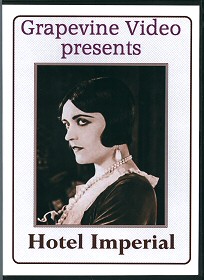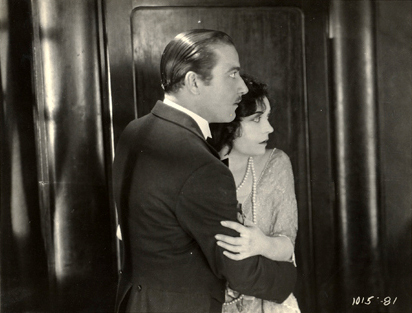
HOTEL IMPERIAL ON DVD
A review by David Gasten
September 30, 2006
Hotel Imperial (1927), starring Pola Negri, James Hall, George Siegmann, Max Davidson, and Nicholas Soussanin. Directed by Mauritz Stiller and produced by Erich Pommer for Paramount Pictures. Silent, 77 minutes. DVD released by Grapevine video, May 2006.
Also includes bonus short Just In Time (1921) starring Snooky the Chimp and directed by Harry Burns. A Chester film, distributed by Educational Films. Silent, 18 minutes.
(Click to buy Hotel Imperial from Grapevine Video. Click "Add to Cart", and when the e-shopping cart pops up, type "PNAS" into the Customer Code box to receive $2 off this title!)
 |
So far, the best of the public domain DVD releases of Pola Negri movies (next to The Woman He Scorned) has been Grapevine Video’s reissue of Hotel Imperial. Hotel Imperial has suffered a tarnished reputation over the years because of the noticeable three-way tug of war in visual aesthetics that resulted in a hodgepodge of Swedish, German, and American visuals that keep the movie from having a strong visual cohesiveness. However, thanks to an improved transfer from a better-quality print, we can now watch the film in a little better light and see what made the New York Times film critics begin their Best of 1926 film list with a mention of Hotel Imperial (even though they couldn’t include it in the list because of its January 3, 1927 release date).
Hotel Imperial was a film that did well with the critics, but performed poorly at the box office in America because it happened to be released after a strong public backlash against her in America, due in part to Pola’s famed antics at Rudolph Valentino’s funeral (easily the worst acting of her career, although sadly she wasn’t acting!). In retrospect we can see that this incident was the straw that broke the camel’s back in a pattern of poor choices in Paramount’s (mis)management of Pola’s career that ended up alienating her somewhat from American audiences (although she continued to do well with overseas audiences this entire period).
Earlier on in her American career, Paramount cast Pola in a succession of “good bad girl” roles while simultaneously making a Gloria Swanson-style clotheshorse of her. This uneasy mixture was a compromise amongst what women wanted to see (pretty clothes), what men wanted to see (a hot babe seducing them from the screen), and the complaints from women who didn’t want their husbands and sons being seduced by lecherous women in the theaters, as filtered through an American film industry losing ground to their German competitors and yet not understanding the inner workings what made their competitors’ films the threat that they were. The result of so many compromises was that nobody was happy, and Pola’s career began suffering, which meant that Paramount had to rethink Pola’s career. It has been suggested that the Valentino funeral incident was what forced Paramount to reinvent Pola in Hotel Imperial, however Hotel Imperial was already in production when this occurred (and was delayed because of it), which tells us that Paramount had made the decision to reinvent Pola even before this happened. The decision was made to cast Pola in more down-to-earth roles, only in her native Europe. She would now be the girl next door in a European fantasy world. The critics loved the results, but for American audiences the damage was already done and her reputation in America would be in recession for about a year while Paramount finally got around to making great Pola films.
 |
Pola earns her stripes as Austria's "bravest and most beautiful soldier" in Hotel Imperial(1927). James Hall was her leading man in this film, and they are pictured together here. |
And this is where we find Pola in Hotel Imperial. In this film Pola plays the chambermaid at a small hotel in an Austrian town under Russian occupation during World War I. An Austrian army lieutenant fighting for his life behind enemy lines breaks into the hotel Pola works in to evade capture, and having had no rest for several days he falls into a deep sleep. Pola and her co-workers move him into one of the rooms, only to have a Russian general and his troops make their hotel their headquarters. The hotel’s staff members do not want to betray one of their own countrymen, so they disguise the lieutenant as their waiter. The Russian general immediately takes a liking to Pola, but she resists him until they nearly take the “waiter” away for not having identification. She then appeals to the general and turns on the charm to save the lieutenant/waiter’s life. The plot thickens when the Russian camp is visited by one of Russia’s best military spies. The spy has found the locations where the Austrians have stockpiled their reserves and has one more trip to make across enemy lines to gain enough information for the Russians to hit the Austrians with a fatal blow that may end the war in their favor. The lieutenant, still disguised as a waiter, overhears this, and when the spy returns he kills the spy in his bath. Pola and the lieutenant destroy the information the spy brought with him and try to disguise the murder as a suicide, but the general does not believe it and begins to hold court, having everyone in the hotel questioned. The Russians suspect the lieutenant, and then Pola does something to rescue him again and later receive honors from the Austrian government as their “bravest and most beautiful solider”—but you’ll have to watch the picture to find out what she did…
The three-way tug of war in visual aesthetics results from the film being made by an American film company under the supervision of German producer Erich Pommer (who worked before and after this for UFA), with Swedish import Mauritz Stiller (who was brought over to America along with his actress protégé and girlfriend Greta Garbo because of industry interest in his film Gosta Berling’s Saga) directing the film. The American film company had a set style for the films they produced and expected the film to be made within these confines, while the German producer pushed for the artistic motifs that had become prevalent in his home country. Paramount let him do this, knowing that they needed to rely on the German producer somewhat in order for their film to stand up against their German competitors. Therefore, we have a German producer working within the structures of the American film factory, obsessing over staircases and shadows, carefully organizing shots in a geometric fashion, and dizzying us with moving cameras. Pommer ingested what he learned while working for Paramount, and took the resulting German-Hollywood filmmaking hybrid back to Germany with him, producing a series of German films that have a similar hybrid look. In fact, one of the German films he produced later on, Hungarian Rhapsody (1928), contains a dance sequence with moving cameras that is very similar to the dance sequence in Hotel Imperial.
Swedish director Mauritz Stiller, on the other hand, found himself less a creative force than a timekeeper for the studio, which was a very depressing situation to him and led to his dismissal from Paramount. He and fellow Swedish director Victor Sjöström (or Seastrom, as he was later credited) created a world of stark, unflinching bleakness that rang strong with the audiences in their home country and caused them to become the most famous directors in Sweden during that time. Although their films were not as artistically stylized and geometric as the Germans’ films, Stiller and Sjöström took the darkness found in German silents to much more brutal extremes. The hanging lamps and streetlights of German fame get prominence in Scandinavian pictures as well, but the claustrophobic blackness and somber subject material, no doubt influenced by the long, unflinching winters in their native habitat, get “cranked up to eleven” in their pictures. These Swedish directors were also more prone to use natural settings than the Germans, probably due to budget constraints as well as to their collective love of nature.
Stiller’s influence is squashed somewhat in Hotel Imperial, but shows up powerfully in the military sequences at the very beginning and end of the film, as well as in the two war montages ten and sixty-eight minutes into the film. We also see his influence in certain shots inside the hotel, where loosely organized extras congregate underneath suffocating overhead lighting with pitch-black darkness outside.
Although not as crisp-looking as many mainline DVD releases, the visual improvement is noticeable and makes for a much more enjoyable watching experience. We still have a picture that is a little too dark around the edges and find numerous scratches on the film itself, but at least we can see the shadows and nightmarish montages with some clarity now. The compiled orchestra score also brings out the best in the film for the most part, even following scene changes and subtleties of mood in the film itself. How’d they do that? There are a couple parts that don’t work so well (namely the a cappella chorus toward the end of the film), but overall the score goes out of its way to enhance the film, which is really amazing considering that it is a complied score and not actually written for the film.
Hotel Imperial is a film that one appreciates more and more with repeated viewings. Although already a great story that utilizes a strong sense of suspense, we can now find further beauty in the subtle details of the cinematography. The three-way tug-of-war for the visuals is still present, but with the new transfer we can see that the visuals are not quite as unharmonious and/or inconsequential as they once appeared. Thanks to Grapevine’s new transfer, we can now appreciate the film much closer to the way it was originally meant to be appreciated.

